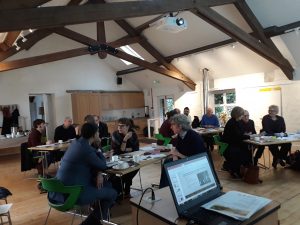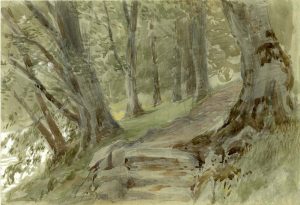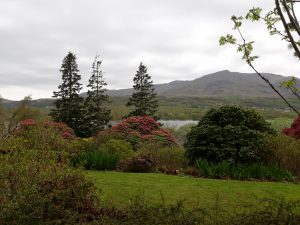Our second blog is by Dr Joanna Taylor, Presidential Academic Fellow in Digital Humanities at The University of Manchester.
In March 1991, shortly after Lancaster University had launched their campaign to acquire the Whitehouse Collection of Ruskiniana, the eminent Victorianist Dinah Birch offered a suggestion as to why John Ruskin – one of the most important and wide-ranging thinkers of the nineteenth century – had lapsed into obscurity. She thought that Ruskin’s interdisciplinarity was a barrier for the modern reader: ‘his influence,’ she wrote, both then and now, ‘was fragmented by the bewildering range of subjects he undertook to write about’.

The result, in Britain at least, was that Ruskin seemed ‘tangential’ to a wide range of subjects: art historians, political economists, literary scholars, historians, geologists, biologists, ecologists and sociologists could all claim Ruskin as one of their own with equal felicity, but no one discipline could aspire to a complete understanding of Ruskin’s polymathematical thought. As Birch concluded, Ruskin’s writing is:
rooted in the widest definitions of culture. To be read fully, the texts call for knowledge of Greek literature and mythology, Medieval iconography, Milton, 18th-century fiction, the Bible, geology, Italian history, botany, Walter Scott and Dickens, and a very great deal else besides. They ask to be studied on their own terms. There will never be many who are in a position to rise to the challenge of interdisciplinarity on quite that scale. (‘Interdisciplinarity’, London Review of Books 13.12 (1991), https://www.lrb.co.uk/v13/n12/dinah-birch/interdisciplinarity).
Birch is right that, today, it would be a rare lone scholar who could match the breadth and scale of Ruskin’s knowledge. But what was a stumbling block for the twentieth-century model of lone-wolf scholarship – particularly in the humanities – might become an enabling force in more recent approaches that emphasise interdisciplinary collaboration.

So the Lancaster University Away Day at Brantwood, Ruskin’s home from 1870 until his death in 1900, discovered. This event aimed to facilitate precisely the kind of ambitious cross-disciplinary environment needed for the sort of scholarship that can begin to rediscover Ruskin for a new era. With invited speakers and attendees from the University’s principal research centres – including Digital Humanities, Material Sciences, Data Sciences and Social Futures – the Away Day demonstrated Ruskin’s potential to offer an intellectual bridge between radically different interests.
The morning began with an introduction by the Director of The Ruskin, Professor Sandra Kemp. Kemp introduced Ruskin as a figurehead for the Library’s ambition to be a ‘museum of the near future’. Kemp asked what the purpose of a collection of materials – a collection, moreover, that surpasses any other for a single author – is in a campus environment. As she suggested, when understood as the backbone of a forward-looking museum, the Collection offers the basis for using Ruskinian materials and thinking as a springboard for addressing ongoing social, cultural and environmental issues. If we re-interpret the Collection as an active, malleable archive, she indicated, it becomes a valuable resource for research, teaching and public-facing exchange.

The following talks all, in different ways, spoke to this vision of a dynamic Collection that catalyses exciting new research in each University faculty. Dr Andrew Tate (Reader in Literature, Religion and Aesthetics) demonstrated how forward-looking interpretations of Ruskin might work in future exhibitions at the library. Professor Judith Mottram (Director of Lancaster Institute for the Contemporary Arts) suggested how Ruskinian thinking could develop creative practice as research that re-evaluates art, not as illustration, but as an active force in engaging diverse publics in socio-cultural, political and academic agendas. Professor Beth Harland’s talk revealed how such a re-evaluation could facilitate creative responses to Ruskin’s work and his wider contemporary relevance that, she suggested, are based on the ‘critical production of knowledge’. She uncovered Ruskin’s interests in interactive thinking by interrogating what role ‘conceptual relationships’ might play in future research at Lancaster.
Between these talks, each group – each of which focused on a different research agenda (Digital Humanities, Material Sciences, Social Futures and Data Science) – reflected on how Ruskin or Ruskinian thinking might guide future collaborative endeavours and lead to new research areas. Ruskin’s interests in work, memory, sensation and the details of the world around him offered rich starting points for frequently surprising conversations that began to uncover the power of Ruskin’s thought for developing innovative research questions.
Brantwood, the site of – among other things – Ruskin’s infamous meeting with Darwin, offered the ideal location for this cross-disciplinary brainstorming. A guided walk around the house and grounds with the museum’s Director, Howard Hull, consolidated the morning’s communal discoveries of interlinked research interests. Ruskin’s allegorical garden, known as the Zig-Zaggy, was a particular highlight. This material re-imagining of Dante’s Purgatorial Mount, based on one of Ruskin’s own designs, guides the visitor up the fellside along a series of themed terraces until they reach ‘Paradise’s’ unparalleled view across Coniston lake to the fells beyond.

The garden offered a focal point for our final list of take-aways from the day. More than anything, this re-imagining of an alternative type of Ruskin text had indicated to everyone present the scope for playful (re-)interpretations of Ruskin. It seemed to encapsulate the day’s aim of taking Ruskin out of dusty volumes on dark library shelves, and into the real, twenty-first century landscape.
The garden consolidated what the rest of the day had implied: that Ruskinian thought – as well as his specific works – might offer creative opportunities for new kinds of research that linked ordinarily disparate parts of the University, as will be showcased in The Ruskin’s launch exhibition on 25 September. What the Away Day ultimately demonstrated is that the man George Eliot called ‘a prophet for his generation’ is also deeply prescient for our own.

